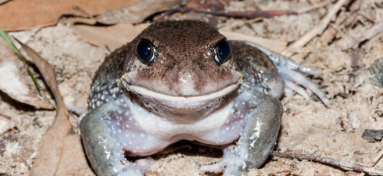
On the Northern Beaches the Giant Burrowing Frog occurs in Eucalypt forest, woodland and heathland, usually on Hawkesbury Sandstone. It breeds deep in burrows in the banks of small densely vegetated creeks and drainage lines. Outside of their three to 10 day breeding season, the frogs may disperse hundreds of metres away onto nearby ridges but only during wet weather. Most of the time they are in burrows. but may also shelter under fallen logs and in dense undergrowth.
The adult frogs feed on small insects and other invertebrates (e.g. ants, beetles and spiders) taken on or near the ground or in water. The tadpoles feed in water on plant material and detritus.
For breeding, the Giant Burrowing Frog apparently requires small watercourses or pools that are clear and unpolluted. The species often breeds twice a year, in spring and again in autumn, although this varies greatly depending on rainfall. Eggs are laid in a foam nest near one of the openings of the breeding burrow, under vegetation or in yabbies holes.
After rain the burrow may flood, releasing the tadpoles to complete metamorphosis in a creek or shallow pool. A study assessing the effect of sediment on Giant Burrowing Frog tadpoles suggested that this species copes with some increase in sediment in the water. However, they require a relatively low and constant pH, which is naturally found in undisturbed sandstone environments, and do not cope in more neutral or alkaline pH.
